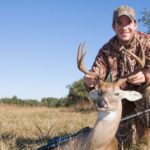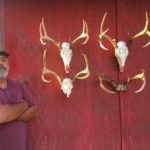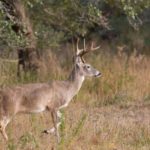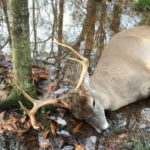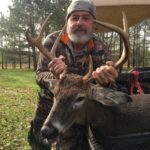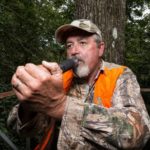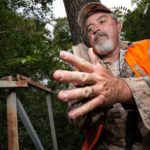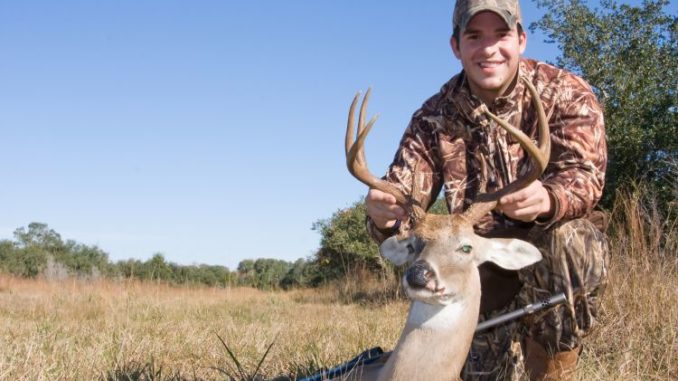
Many hunters think rattling is for out-of-state trips, but this Franklinton buck killer knows it might be the best tool to draw out big, mature deer. So use his tactics to take a real wallhanger this season.
Teenage boys have a saying they sometimes use to express an understanding that they will put their fraternal friendships ahead of any teenage girls who might try to come between them.
Since some might consider this saying offensive and not proper to put in a family hunting publication, I’ll doctor is up a little bit and make it fit.
Bros before does.
While these boys generally try to live up to this valiant code, ask any teacher the root of fights between these same boys, and they’ll inevitably answer, “Girls.”
That’s because boys have been fighting over girls from the beginning of time.
And when boys eventually do square off over a girl, the spectacle of pubescent posturing, callous cursing and flailing fists attracts quite an audience of onlookers.
Some might circle the fight just to see who wins, but others might be there to see the girl who caused the fight — and perhaps offer her an alternative.
According to Franklinton deer hunter Joey Roberts, there isn’t much different between teenage boys and rutting bucks.
Bucks tend to gather in bachelor groups for much of the year, and I’m sure there’s a lot of bros-before-does talk going on.
But when the rut kicks in, these bucks that were amicably sharing acorns weeks before start fighting over the very does they spent much of their summer and fall dissing.
This is why Roberts started experimenting with rattling when it first came on the scene in the 1970s.
Since then, he’s rattled the cage of many a big buck.
Rattling is a technique involving smashing deer antlers together to simulate the sounds of fighting bucks. The idea plays on the age-old idea that the sounds of a fight will attract a crowd — especially if a nearby buck believes interlopers are fighting over one of HIS does.
“I was just kind of half-heartedly fooling around with it at first, with very limited results,” Roberts said. “But (former Louisiana turkey study leader) Jimmy Stafford invited me to hunt his family property one time and told me I might want to bring my rattling horns.”
Roberts kind of laughed it off, but he dutifully carried his rattling gear with him.
“I grunted and rattled a couple times just as soon as the woods settled down, and it sounded like the wrath of God coming down in those woods,” Roberts said. “About a 2½-year-old 8-point came blasting in there with his hackles up on his back.”
Roberts knew Stafford tried to manage his property, so he let that deer walk.
He told Stafford about the encounter — and Stafford coincidentally went back later and killed that same buck.
Since then, Roberts has continued perfecting the technique to better work on Louisiana deer — and in a state where many believe rattling horns are best left at the house packed up for trips to Texas or Missouri, Roberts rattled up two great bucks last deer season.
He killed one, and his wife Kim killed the other.
Right place, right time
The primary evolution of his rattling has more to do with timing than anything else.
“When I started rattling according to the rut, my success skyrocketed,” Roberts said. “The last 10 years, I’ve been mainly rattling around (Franklinton) the first week of January.
“And I can tell you that probably 99 percent of the bucks I rattle in are during that first week anywhere between about 10 in the morning to 3 in the afternoon.”
The key to this timing around Franklinton is that the local deer are past the pre-rut stage but not quite into the full-blown rut.
Bucks are definitely cruising for does, but they aren’t fully locked down with them.
Roberts is also as specific about his locations as he is with his timing.
For instance, he shuns Louisiana’s many pine forests in favor of open bottoms.
“If there’s a little water in (a bottom) that’s a bonus,” Roberts said. “Water or dry leaves — it doesn’t matter, as long as I can hear them coming.
“Obviously, pine plantations don’t work so well because the needles on the ground muffle the sound.”
Hearing deer approach is extremely important, because if Roberts doesn’t get any action with his first rattling sequence he’ll pick it back up in 45 minutes to an hour.
“If a buck has slipped in on me without me hearing it,” he said, “he’s liable to be standing close enough to pick me off as soon as I start all that commotion again. I’m busted, and he’s gone because when they come in they’re looking for something — ears cupped and eyes as big as pie pans.
“If they come in quiet, they’re likely to spot me before I spot them.”
Another criteria for any potential rattling spot is that it must be an area that has had zero hunting pressure and in which he also has reason to believe is holding a mature buck.
“I’ve killed five deer in the last seven years by rattling out of the same stand on a little place I hunt,” Roberts said. “I go in just before the season and check my stand and do a little limb trimming, and I don’t go back in there until the first week of January.
“I just don’t even fool with it.”
Basically, Roberts believes all the hunting pressure on surrounding properties pushes mature deer into his little area. They’re in there undisturbed for three-quarters of the season, and when he goes in and tries rattling it will be the first or second hunt that he kills one.
“If I’m lucky enough to rattle up one and shoot him, I get out and go somewhere else the rest of the season,” Roberts said. “I don’t pressure that area. Nobody else hunts the spot, and the bigger deer on my lease generally are going to be in that area.”
It’s all about the commotion
Although he likes to keep this little piece of woods quiet for most of the season, Roberts doesn’t hold back when he decides it’s time to rattle up a buck — he throws everything he’s got at them.
Observing deer doing what deer are supposed to do hunting outside of Louisiana has taught Roberts that deer are way more vocal than many Louisiana hunters realize.
“When you’re hunting wide-open spaces in Missouri and Texas with nothing to muffle the sound, you hear deer all over,” Roberts said. “I’ve seen deer fighting 300 yards away from me, and it sounded like they were right under my stand.
“They don’t fool around. When the wrong one busts up in another’s territory, it’s on.”
That’s why, when Roberts decides to rattle he doesn’t tink around.
“I’m trying to tear the woods up,” he laughed. “There ain’t no fooling around if you’re going to do it. The idea is to imitate two bucks fighting. They make quite a commotion, so I’ve got to make quite a commotion. I make it sound like two bucks pushing back and forth, with grunting to go along with it.
“It’s got to sound like a hell of a deal to somebody else sitting in a stand on down the woods.”
To make all this commotion sound most realistic, Roberts throws everything he has at them, from a can to a grunt to a snort-wheeze to rattling.
The combination of calls and the way he sequences them pays off in a big way.
Tools of the trade
Over the years, Roberts has settled on a Primos Can, a MADD Buck Roar grunt call, a snort-wheeze with his mouth and a Primos Rattle Bag.
“I’ve tried just about everything when it comes to rattling,” Roberts said. “Natural horns, store-bought antlers and just about every other contraption to ever come along, and I’ve just had better luck with the rattle bag.
“It’s easy to carry, and I don’t have to worry about it making a bunch of racket when I wrap the band around it.”
However, Roberts doesn’t use the rattle bag the way it comes out of the pack. Instead, he remove a couple of the sticks because he believes it gives off a more realistic and louder sound when the remaining sticks have more room to move around.
All the other components of his system help create the illusion of two bucks fighting over a doe.
The can bleat makes it sound like there’s a doe around. The grunt call can be used from anything to tending grunts to fighting grunts.
And it’s all rounded off with the snort-wheeze Roberts makes with his mouth — but he cautioned that this call can sometimes alarm Louisiana deer.
“I believe if you’re going to try to snort-wheeze, you better be in a particular area with a mature buck in it,” Roberts said. “I was hunting a clearcut the first time I tried it, and two bucks — a little 4-point and 5-point — came out.
“I took the chance to try a snort-wheeze on them.”
The last Roberts saw of those two bucks, they had covered the 40-acre clearcut belly to the ground all the way across the highway and into the next piece of woods.
How it’s done
Roberts said he rattles blind most of the time, meaning he’s just going through his rattling sequence in hopes that a cruising buck takes interest.
“I start out using the can bleat three or four times,” Roberts said. “Then I wait 10 or 15 minutes and bleat a couple more times. Then I come back with a grunt or two.
“I kind of build it up to where I’m eventually doing some tending grunts, then wait another 10 or 15 minutes. Then I might try the snort-wheeze before breaking out the rattle bag.”
All told, each sequence can take up to 25 minutes to complete.
If he doesn’t get any takers, Roberts puts everything down for about 45 minutes before starting all over.
“I’ve killed several deer on the second or third sequence,” he said. “The 10-point I killed the year before last, I got in the stand at 9 that morning but didn’t kill him until 2 that afternoon.
“He’s got to be close enough for him to hear you to have any interest. That time of year, I don’t think bucks ever really bed down; they’re on the move all day and all night.”
If Roberts does grab the attention of a cruising buck, he lets the attitude of the deer determine the direction he takes.
“If he comes in doing that sideways walk with hackles up on his back, get ready and keep doing what you’re doing because you’ve got him coming,” he advised. “If he comes sneaking in and stops out there 100 yards, hit him with the can or grunt — not full-blown rattling, because (with) the motion of doing it he’s apt to pick you off.”
What about scents?
Although he doesn’t fool too much with scents, Roberts does everything he can to go into his stand clean because he knows any deer attracted to rattling is going to come in downwind.
“I’ve killed several that were circling around me,” he said. “They may have come from upwind, but they’re trying to get downwind to scent check the sound.”
The bottom line
In a state where few hunters give much thought to rattling, Roberts believes it’s not something Louisiana hunters should dismiss altogether.
Granted, you might go into an area and spook deer, but they’re not going to leave the country: They’ll be back, so you really don’t have anything to lose.
And Roberts feels like rattling in Louisiana has only gotten better since the state implemented the doe tags and doe days.
“I think you’ve got to be in an area with a somewhat balanced herd,” Roberts said. “And I think a low deer density helps because the lower the density the fewer does there will be. That means the competition for the ones that are there will be intense.”
Rattling might not be the first tactic you try this deer season, but to dismiss it entirely could mean missing out on the opportunity to kill the biggest, most-mature buck on your property.
So spend some time this season trying to sound like two bucks fighting over some does, and you just might drop a buck that impresses the heck out of your bros.
